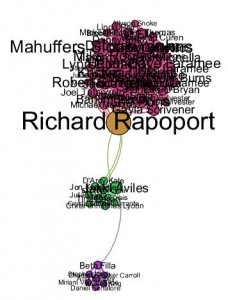I just can’t stop thinking about relationship mapping! Probably because I am deep within a project to use relationship mapping to generate new prospects and illuminate the path to identified prospects within a campaign. A soft touch for new software, I really, really want the product I’m using, Prospect Visual, to deliver the goods. But will it?
The Many Shades of Relationship Mapping
Relationship mapping is not new, but some of the tools used to find relationships are new. Essentially, you create a visual (think family tree style) or data map (like in Excel or a database) or both of someone’s relationships. Many organizations collect this information in the donor database as an afterthought or “extra”. Relationships might be mapped to family members, boards served, club memberships, religious involvement and others. Why, you could even map all of the interrelated relationships of the Mad Men television show characters…

In higher education there may be a wealth of information from the school that connects individuals to one another, such as club membership, degree majors, and sports participation among many others. In 2012, Queens University presented at a CASE conference on their use of TouchGraph to map relationships within their own database.
What some new products, such as Prospect Visual and Relationship Science, are attempting to do is allow you to take the relationships you have collected on one individual and find paths to reach other individuals “out in the wild”.
LinkedIn does a reasonable job of this for prospecting within business networks. I have used LinkedIn, in combination with verbally asking people in my network, to identify paths to prospects I would like to cultivate for business. A personal introduction by someone with a strong relationship is much preferable to a cold call!
A nonprofit organization can use a trustee or engaged volunteer to introduce it to new prospects who are likely to have an affinity for the organization. Nothing new about that!
The Missing Piece: Spheres of Influence
What is new is identifying, perhaps by visualizing, someone’s sphere of influence. Some people are connected to more people and some people have many people in their network that are strong or deep connections. Strong connections suggest that the person can influence the other person. In the triad of Linkage-Ability-Inclination, relationship mapping provides the piece research has not always been so good at delivering in the past: Linkage.
In our book, Prospect Research for Fundraisers, Helen Brown and I discuss relationship mapping in the last chapter. Helen provides a great example of an organization that used its alumni group on LinkedIn to identify individuals who were highly connected and then qualified them for affinity. This process uncovered some great new prospects.

I attended a course at the Nonprofit Leadership Center of Tampa Bay led by social media expert Bryn Warner, and I created a visual representation of my relationships from my personal Facebook page, which I have included here. Just look at all the connections around my husband and my favorite live-music venue, Mahuffer’s! Clearly this represents a sphere of influence. And it’s a messy, tangled ball of yarn, yes? I did not take the time to manipulate the graph results to make it pleasing to the eye or to make the names all readable. Make no mistake, these tools may be powerful, but they are time-hungry beasts!
Analyzing and Verifying
My experience so far using Prospect Visual is two-fold: (1) Visualizing spheres of influence is effective in identifying promising paths to new prospects; and (2) Just as in a wealth screening, this big relationship database is great at prioritizing, but I still have to analyze and verify the information.
What I have been doing so far in Prospect Visual is identifying clusters of relationships – spheres of influence – inside and outside the defined group of individual, foundation and corporation prospects in our project space. While one trustee may have strong relationships to identified prospects, another trustee may have a deep and wide network with organizations and people that my client has not considered before.
Once we see a sphere of influence, the next step is to confirm it truly exists and then discover whether there is any ability or inclination. Because there are errors in the underlying database of relationships – such as duplicate records and connections that are just plain wrong – the connections must be verified. And once the connections are verified, further research is needed to discover those shiny glimmers of affinity.
Getting Results
As with wealth screenings, moving the process from mass prioritization all the way through cultivation and solicitation takes time. It will likely be at least a year before any results, let alone gifts, are realized from the effort. And this project is not exactly number one on everyone’s to-do list. Prospects and donors in active cultivation and solicitation create the crisis of time that vacillate the prospect identification project between hot and cold attention.
Who is at the Watering Hole?
Are you actively using relationship mapping techniques and tools? Do you plan to? Do you wish you could be a fly on the wall hearing about it? Join the conversation! In a geographically dispersed environment where many of us perform prospect research solo, sharing our work successes and challenges builds our profession and ourselves.
Relationship Mapping Work Group
Aspire Research Group has created a free-to-participate work group that meets online. You can join the conversation – or lurk about listening – by signing-up for the email list. I’m looking forward to sharing with you!
